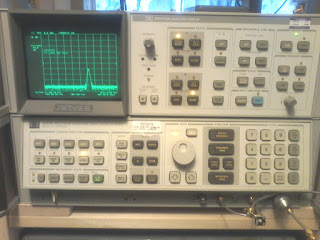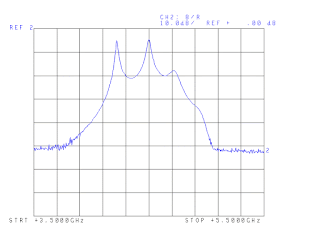I've been doing a bit of eBaying lately,trying to improve on the performance of my millimeter wave mixers and multipliers.The first purchase was an amplifier for 6-16GHz to boost the LO output from my HP 8672A. I thought it would be better than hacking apart my beautiful 83545A plug-in to add an amplifier input.
Here it is behind the flashlight reflector, mounted on a heasink as the current draw of 600mA at 12V would quickly toast it otherwise. It has plenty of gain (over 50dB in spots), so I only need -20dBm at the input to get full output (23-25dBm, depending on frequency).
Inside the flashlight reflector is a new multiplier, mounted on an SMA connector as before, but using an Alpha Industries (now Skyworks) SMS7621-079 schottky diode. The new diode seems to have better efficiency at higher frequencies (above 30GHz).
I also bought an HP 11970K harmonic mixer. I had been looking at the 11970 range for a while, the K version covers the lowest frequency range of 18-26.5GHz, and is generally the least expensive. There are models all the way up to the 11970W, which covers 75-110GHz, but they tend to be very pricey (and rare). I am interested in higher frequencies than 26.5GHz, but the reason I went with the low band one (aside from price) is that it might work at higher frequencies as well, but the high band ones won't work lower as the size of waveguide input limits the low frequencies. There is a seller on eBay who bundles a low band 11970 unit with a waveguide adapter and sells for much more than the typical 11970 unit, but at least the units are tested to operate at higher frequency. I built my own waveguide adapter as the photo shows, it converts the WR42 input to about a WR22, with a low frequency cut-off of about 26GHz. This way, I know that if a signal shows up above 26GHz, I'm not just seeing an image of a much lower frequency (like my multiplier fundamental input frequency).
Here's the result: a good signal at 47.1GHz (plotted using my beautiful Prologix GPIB-USB).
It also does 77.7GHz
And 122.5GHz
And even 135GHz (but up here the signals are dropping into the noise). I tried for 249GHz, but no luck. I think an amplifier on the LO line for the 11970K might help; the LO input level is supposed to be at least 14dBm, and at 6GHz I measure only 6dBm out of the LO output on the 8566B. I see an amplifier purchase in my future....
Here it is behind the flashlight reflector, mounted on a heasink as the current draw of 600mA at 12V would quickly toast it otherwise. It has plenty of gain (over 50dB in spots), so I only need -20dBm at the input to get full output (23-25dBm, depending on frequency).
Inside the flashlight reflector is a new multiplier, mounted on an SMA connector as before, but using an Alpha Industries (now Skyworks) SMS7621-079 schottky diode. The new diode seems to have better efficiency at higher frequencies (above 30GHz).
I also bought an HP 11970K harmonic mixer. I had been looking at the 11970 range for a while, the K version covers the lowest frequency range of 18-26.5GHz, and is generally the least expensive. There are models all the way up to the 11970W, which covers 75-110GHz, but they tend to be very pricey (and rare). I am interested in higher frequencies than 26.5GHz, but the reason I went with the low band one (aside from price) is that it might work at higher frequencies as well, but the high band ones won't work lower as the size of waveguide input limits the low frequencies. There is a seller on eBay who bundles a low band 11970 unit with a waveguide adapter and sells for much more than the typical 11970 unit, but at least the units are tested to operate at higher frequency. I built my own waveguide adapter as the photo shows, it converts the WR42 input to about a WR22, with a low frequency cut-off of about 26GHz. This way, I know that if a signal shows up above 26GHz, I'm not just seeing an image of a much lower frequency (like my multiplier fundamental input frequency).
Here's the result: a good signal at 47.1GHz (plotted using my beautiful Prologix GPIB-USB).
It also does 77.7GHz
And 122.5GHz
And even 135GHz (but up here the signals are dropping into the noise). I tried for 249GHz, but no luck. I think an amplifier on the LO line for the 11970K might help; the LO input level is supposed to be at least 14dBm, and at 6GHz I measure only 6dBm out of the LO output on the 8566B. I see an amplifier purchase in my future....


























